'That's me': Man from VE Day photo recalls life in bombed city
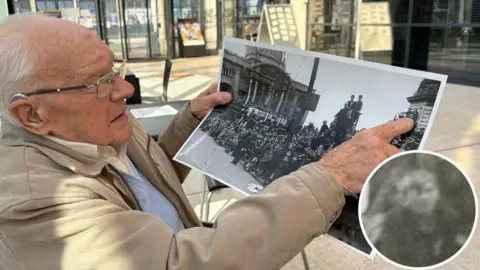 Kevin Shoesmith/BBC
Kevin Shoesmith/BBCOn 8 May 1945, Britain rejoiced when Germany surrendered, bringing to an end the war in Europe. Ahead of the 80th anniversary of VE Day, BBC News delves into wartime archives in Hull; a city which bore the brunt of the German Luftwaffe's attacks.
"That's me," says Brian Farniss, 92, pointing to a young boy in a photograph; one face in a sea of thousands packed into the city's Queen Victoria Square for a victory parade.
Mr Farniss was 12 years old when Hull joined the nation in celebrating victory in Europe in May 1945, which preceded victory over Japan and the end of World War Two.
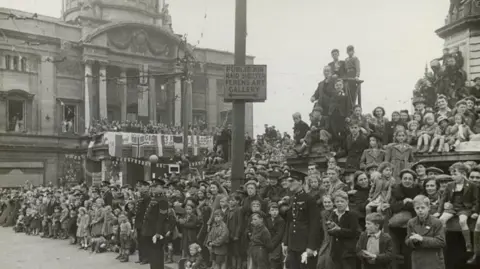 Hull History Centre
Hull History CentreToday, sitting in Hull History Centre, where this photograph and thousands of wartime records are stored, he describes one of the most vivid recollections of his childhood.
He says: "I played the cornet. That day, we marched, ahead of the armed forces, up Whitefriargate to Queen Victoria Square. We all wore sailors' uniforms in support of the Forces.
"There was euphoria. It was a cacophony of noise, people cheering, clapping. We were all clapping our hands until they were sore. It really was a wonderful day. There was also a huge sense of relief."
Competing for the best view of the celebrations, Mr Farniss, along with other children, clambered up onto a statue of Queen Victoria that still looms over the square.
A friend of Mr Farniss saw the photograph used to promote an event to mark the 80th anniversary of VE Day, and asked him if he could spot himself in the crowd.
"I knew it was me," he says. "I can remember exactly where I was standing. I also recognise some of the people stood around me."
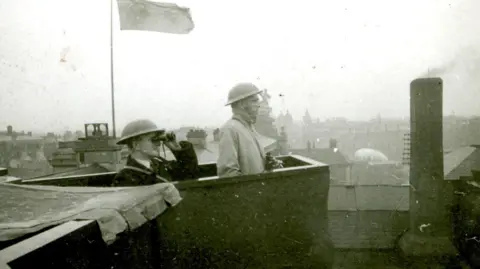 Hull History Centre
Hull History CentreMr Farniss tells of a traumatic start to his life; his mother dying when he was aged three.
"My father was in the Royal Navy, and so me and my brother were sent to live at Hesslewood Orphanage, the most wonderful place," he says. "We had a band. That's why I was there, in the square.
"For us children, war was one big adventure. At that age, you don't really know a lot, do you?
"None of us children thought, even for a moment, we might not survive. It was always going to be someone else, never you. It was never in doubt that we would win the war, either."
Yet he still remembers the incessant drone of the German bombers that followed the path of the Humber Estuary to deliver their deadly payloads on Hull.
"Our shelter was in the cellar," recalls Mr Farniss. "During the Blitz, we didn't bother going to bed. At bedtime, we just went straight down to the shelter.
"In the morning, the smoke would hit you. There would be this strong smell of burning and decay.
"One time, fragments from exploding shells [from a nearby anti-aircraft battery] came through the roof of the gymnasium as we made our way down. I picked a piece up - believe me, it was very hot."
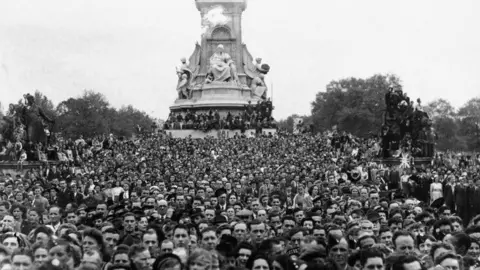 Harry Todd/Fox Photos/Hulton Archive/Getty Images
Harry Todd/Fox Photos/Hulton Archive/Getty ImagesCity archivist Martin Taylor, who manages Hull History Centre, describes Mr Farniss's recollections as "remarkable".
"We were hoping, seeing the size of the crowds [in 1945], that there would be some people still who remembered it."
While some in the photograph, against the backdrop of bombed out buildings, are clapping, others have sunken, haunted expressions, showing the impact of survival in the most bombed city after London.
Mr Taylor says: "A broad range of emotions will have been felt that day - huge relief, certainly.
"But also, I think, grief and sadness. Many were killed. We must remember the war against Japan was still going on, and it would be a while before people back home were reunited with service personnel."
Yards from where the photograph was taken stood the Prudential tower; a prominent building that took a direct hit on the night of 7/8 May 1941. About a dozen people who were sheltering in Ye Mecca Café, in the building's basement, died, according to Mr Taylor.
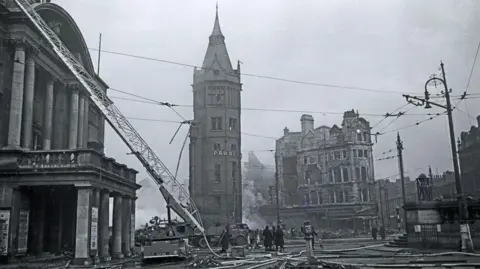 Hull History Centre
Hull History Centre"The biggest single loss of life was the bombing of Ellis Terrace, off Holderness Road, in April 1941," says Mr Taylor. "Fifty-seven people died here when a shelter took a direct hit from a parachute mine."
Most who lived during the darkest chapter in modern British history have been lost to time.
But testimonies survive.
Mr Taylor tells me: "An essay-writing competition, with the title 'What happened to me and what I did in the air raids', was rolled out. Several hundred of these essays were submitted."
He admits he felt emotional when he first read them.
"We don't often hear from children during war," he says. "But we have their testimonies in the historical record. Some of these girls had people die in front of them".
He allows time for that last sentence to hammer home.
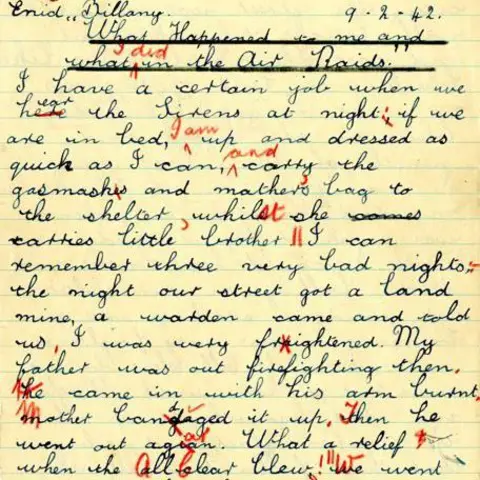 Hull History Centre
Hull History CentreOne pupil, Nancy Nunn, wrote: "We went down to the underground shelter.... the people were very frightened indeed. I was terrified... I thought my time had come, and so did the other people... it made my nerves terrible and it made a lot of difference to me."
Hull still bears the physical and emotional scars of the war.
A short walk from Queen Victoria Square is Albion Street Car Park.
"That was the Royal Institution, a museum, until it was destroyed in a raid," says Mr Taylor.
And in Beverley Road, on the approach to the city centre, the remains of the National Picture Theatre, brickwork still charred, serves as a poignant reminder of Hull's war.
Mr Taylor believes it is right the 80th anniversary of VE Day is commemorated.
"World War Two was the defining moment of the 20th Century, no more so than in Hull - the most heavily bombed city in the country outside of London."
Returning to the image, Mr Farniss focuses on his younger self.
"It's very important we remember," he says, softly.
Listen to highlights from Hull and East Yorkshire on BBC Sounds, watch the latest episode of Look North or tell us about a story you think we should be covering here.


